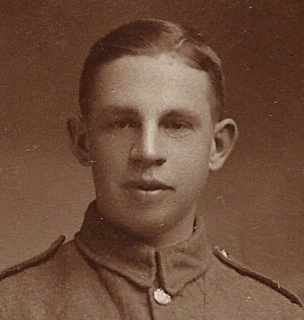
Edwin Boothman 26th March 1900 - 7th December 1993
photograph c 1918 aged 18
This page tells the story of George Edwin Boothman (Edwin) who was born
in the year 1900. It covers the period from his birth on 26 March
1900 to his marriage on 30 April 1923. His age is given with the
date at the top of each entry. The diary entries are based around stories told
to me by Edwin, letters he sent in later life and documentary evidence.
(An outline biography of Edwin to his death in 1993 is given in the footnote at the end of this page.)
George Edwin Boothman - Birth 26th March 1900
George Edwin Boothman was born on 26th March 1900, the third of six children of William Boothman and his wife Sarah. William was a butcher in the Yorkshire town of Todmorden and the family lived at 6 Swan Place. For the history of the Boothman line before 1900 see the Boothman Line.
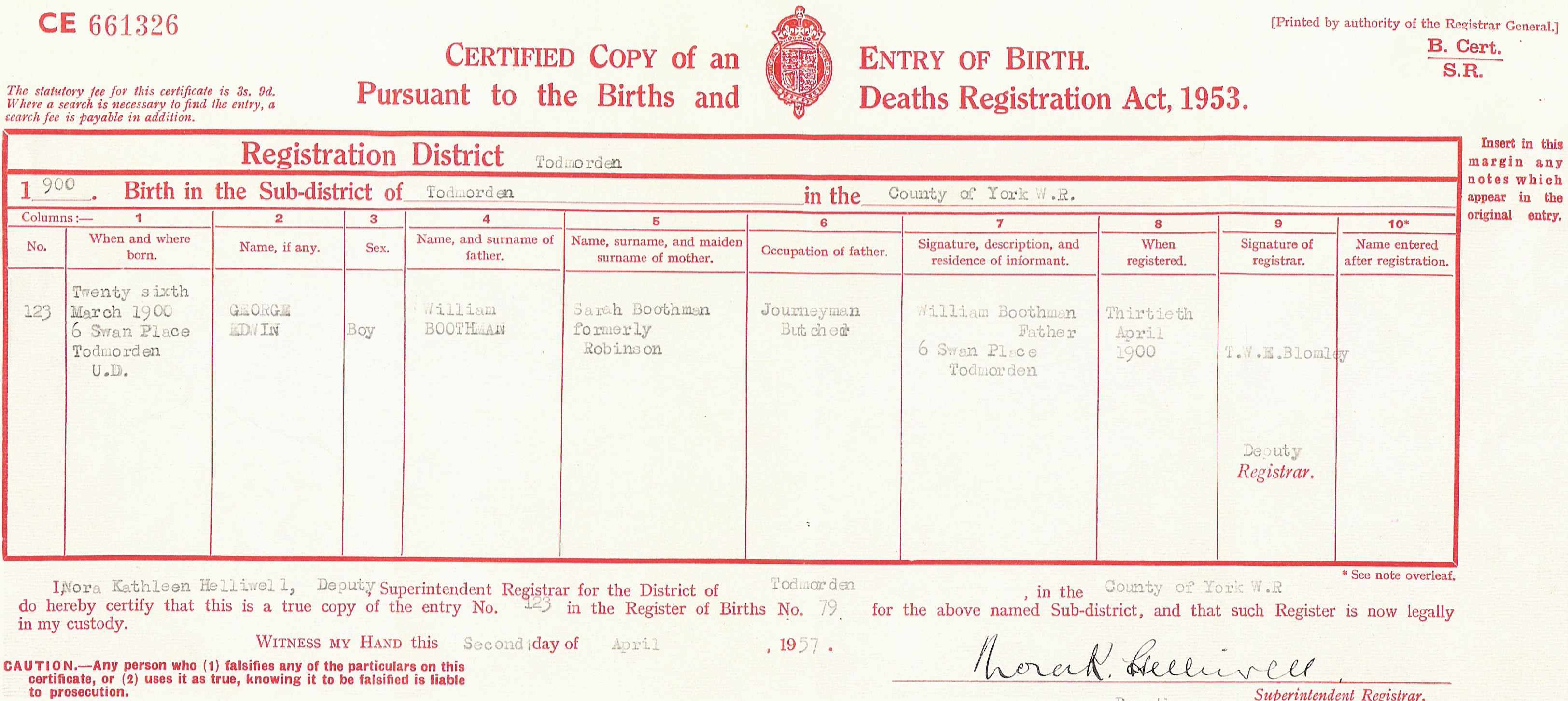
Edwin Boothman - 1901 Census
The Census record for 1901 shows the family to be living at 6 Swan Place. There is also a Back Swan Place so this was presumably a back-to-back terraced house. The address no longer exists - the houses may have been gone for some time and the land was sold for redevelopment in 2009 - see this extract from a 2009 Cabinet Meeting of Calderdale MBC.Swan Place/Coal Street in Todmorden.
4.12 Councillor Battye also comments on the above site. There is substantial demand for affordable housing in the upper valley. Given this, it is considered that the site would be developed to meet such need. The garage structures are privately owned but the sites are let to the occupiers by the Council on short-term leases, which do not have any protection. It is not therefore considered appropriate to consult with the garage occupiers. The site will be sold subject to the existing rights of the garage occupiers. The further issues outlined are again issues which may be dealt with under the statutory planning process. It is therefore felt that the disposal should proceed.
In 1901 the Boothman family was living in 4 rooms at number 6 Swan Place and the key details are as follows:

Many of the other residents of Swan Place (same page of the census) worked in the cotton industry.
William Boothman’s occupation is given as general labourer on the census form but as journeyman butcher on Edwin’s birth certificate. Muriel remembers William, her grandfather, as later working for the gas board – see 1911 census. Their house always smelled awful because of the smell of gas he carried home on his clothes.
The census record also reports that Sarah was born in Holland. Her father, Edwin Green Robinson was a Yorkshire man, a cotton engineer, who travelled to Holland to work and there met his wife Johanna. They returned to Yorkshire when Sarah was a child. Full details of the life of Edwin Green Robinson are given in the section Robinson Line.
George Edwin Boothman - Baptism 6th September 1902
According to
this record from West Yorkshire Births and Baptisms 1830-1910, Edwin was baptised
at the same time as his sisters Alice and Edith on 6th September
1902 at Christ Church, Todmorden. The family was now living at number 2 Swan
Place.
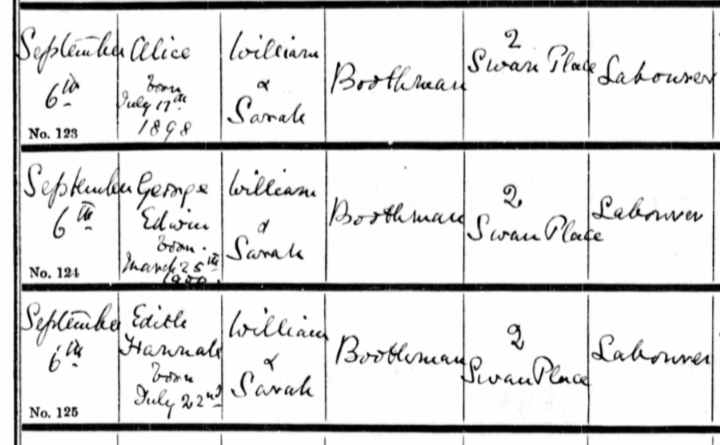
1905 - Edwin (5)
I attend Castle Hill School in Todmorden like all my brothers and sisters. It is a small Church school of just over 100 scholars. Our teacher always takes the class out to see seasonal changes. Once we came back and we had to paint the first snowdrop.
I do not know
whether Castle Hill School took children all through from aged 5 or was just
for older pupils. The small Church school may have been somewhere different.
Nor do I know much about Edwin’s schooling - I do not recall ever hearing him
speak of it. The information above comes from a letter Edwin wrote in 1986.
My mum has had a baby - a little boy. He will be called Fred.

The BC is just the
short form with little information. The baptismal record from West Yorkshire
Births and Baptisms 1830-1910 has the above information.
Edwin was especially fond of his youngest brother. I met Fred (my mother called him Uncle Teddy) many times, both in Todmorden and when he visited my parents.
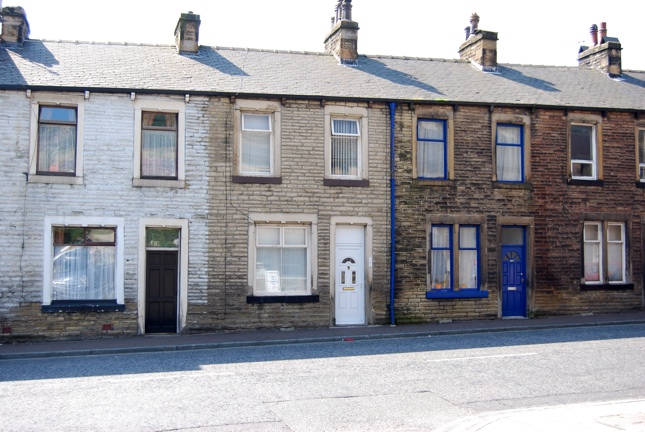
Edwin
Boothman - 1911
Census
The census record for 1911 shows the family to be living at 262
Halifax Rd, Todmorden. This property is still there - the one with the white
door.
Children started work in the cotton mills at 12 when they became 'part-timers' attending school for half the day and working in the mill for the other half. At 14 they left school and became full-time workers - see Alice and John in the following record and see below for Edwin's account.

911 - Edwin (11)
We went to Barnoldswick to visit my Grandma. She is called Rachel Boothman (nee Myers) and she is a formidable Victorian matriarch, but perhaps she had to be. She was left a young widow with seven children after the early death of her husband, John Boothman. She left Barnoldswick after he died and went to keep a pub, 'The Bird i'th' Hand' at Summit, 3-4 miles from Todmorden. Later after her children had left home she returned to Barnoldswick.
She is very strict not only with us grandchildren but with her own children who are grown men. I once saw her box my uncle Fred around the ears when she disagreed with something he did!
Grandma lives with my Aunt Kerenhappuch in Barnoldswick. What a strange name Kerenhappuch is! I think it comes from the Bible.

Edwin went with his father
and his brother Jack to the funeral of Rachel Boothman in 1924. She is buried
in Gill Church, Barnoldswick. The 1911 Census record has no full address but
one of the people I was corresponding with about the family in 2013 had an address of 13 Rosebery Terrace Barnoldswick. She could not remember where this
information had come from.
1912 - Edwin (12)
On Good Friday a group of boys of my age dressed with red braid on the side of our suit and blacked our faces. I think we intend to be Eastern travellers and we sang some tunes accompanied by clackers in our fingers. After singing on the streets we collected coppers from the people and some of the more adventurous boys learned and recited a little play about St George and the Dragon. The boys represented the hero and one of them the dragon and the group did a little dance and jingle in a ring - St George slaying the dragon. We spent the money at the annual fairground but strictly after the time the church services had finished say 1-o-clock. Many of the faithful went to the Good Friday services and the shops railways and buses all closed down and the mills all stopped for the day.
On the fifth of November we made a caricature of Guy Fawkes and carried him around saying “give a penny for the Guy” and the pennies collected were spent on fireworks sat round a bonfire on the edge of which we roasted potatoes peeled when almost burning and eaten with a pinch of salt. All this went on with many accidents

The extracts above come from letters that Edwin wrote in 1989 & 1982.
1912 - Edwin (12)
I have started working as a part-timer as a weaver in the mill. I still go to Castle Hill School for half the day. One week I do mornings in the mill and afternoons at school and the following week the opposite. This is not my first job really as I have helped Uncle George on his ice-cream round for years. He has two horses to pull the ice cream wagons and I help him with the round and then with the horses.
The photograph shows Uncle George Robinson - date unknown. George was the brother of Edwin's mother Sara. For more about the Robinson ancestors see the Robinson Line.
1915 - Edwin (15)
I started work today for Duckworth's in Todmorden. I am going to train to be a manager and someday I shall have my own shop. My wages at the moment are eight shillings per week, which is a bit less than I got when I worked in the mill, but when I have finished training I shall be earning more. I have done a year full time in the mill since leaving school at 14.
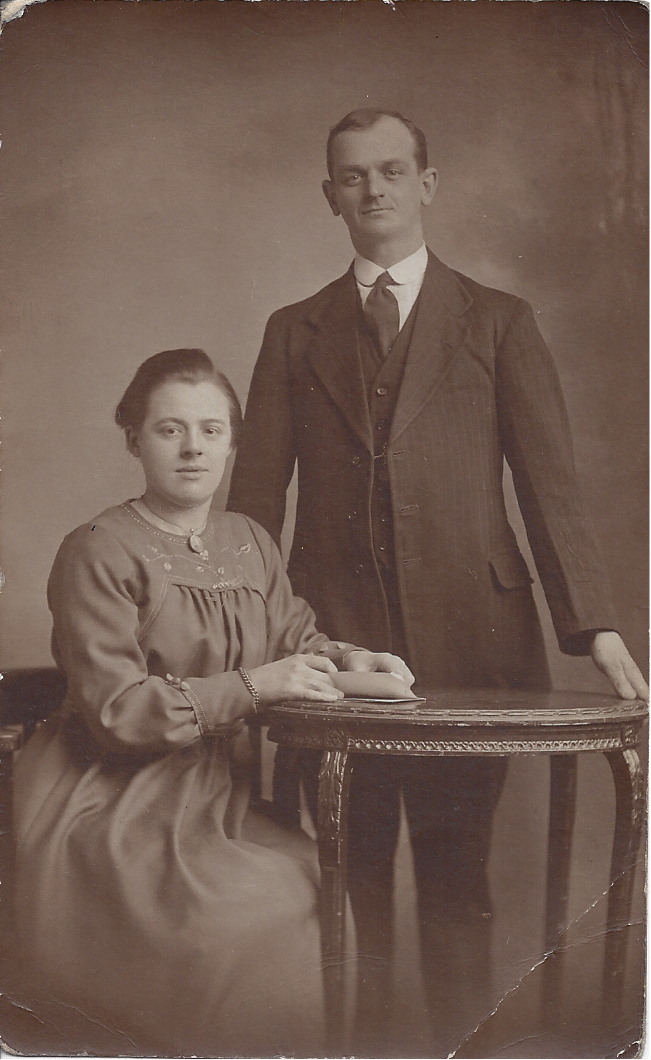
25th September 1918 - Edwin (18)
My sister Mary was married today to Jack Carpenter.
I do not have a wedding photograph but Mary & Jack's daughter had the original of this photo of her parents and sent it to me for copying in 2013 - the original has a date stamped on the back Jan 1919.
In 2013 Jack's daughter wrote the following pen portrait of her father.
My Dad served in the army in WW1 and was wounded 3 times. He lost 2 brothers in the war and another brother had sleeping sickness*. Dad's youngest brother was still a child and sent comics to my Dad and his comrades fought over them - unbelievable but true.
He was a man very like Edwin: teetotal, non-smoker, with a strong social conscience. They only differed in their approach to war - Edwin was pretty much a pacifist whereas Jack believed war was sometimes necessary
He worked in the cord room at Mono Mill in Todmorden. He had to retire at 65 because of chestiness - cotton processing did people no favours. The local wine merchant was pleased to give Dad a part time job in his small warehouse - he had never employed a non-smoker, non-drinker before.
At Christmas we would visit each of Mum's family meeting cousins, having special teas, and at Edwin & Bertha's always one new game each year.
Dad taught me much. He always said "I'm not a clever chap" but he had a store of knowledge that could better many today. Always see the other side of a problem was his teaching. He loved to read the newspaper, as I do still. Dad, like Edwin, would always help anyone whenever he could and was always cheerful and contented with his life.
* This strange plague affected over 5 million people worldwide in the early 1920s. It was never fully identified and disappeared as suddenly as it had started.
This record of the marriage comes from the Ancestry website - West Yorkshire, England, Marriages and Banns

11th November 1918 - Edwin (18)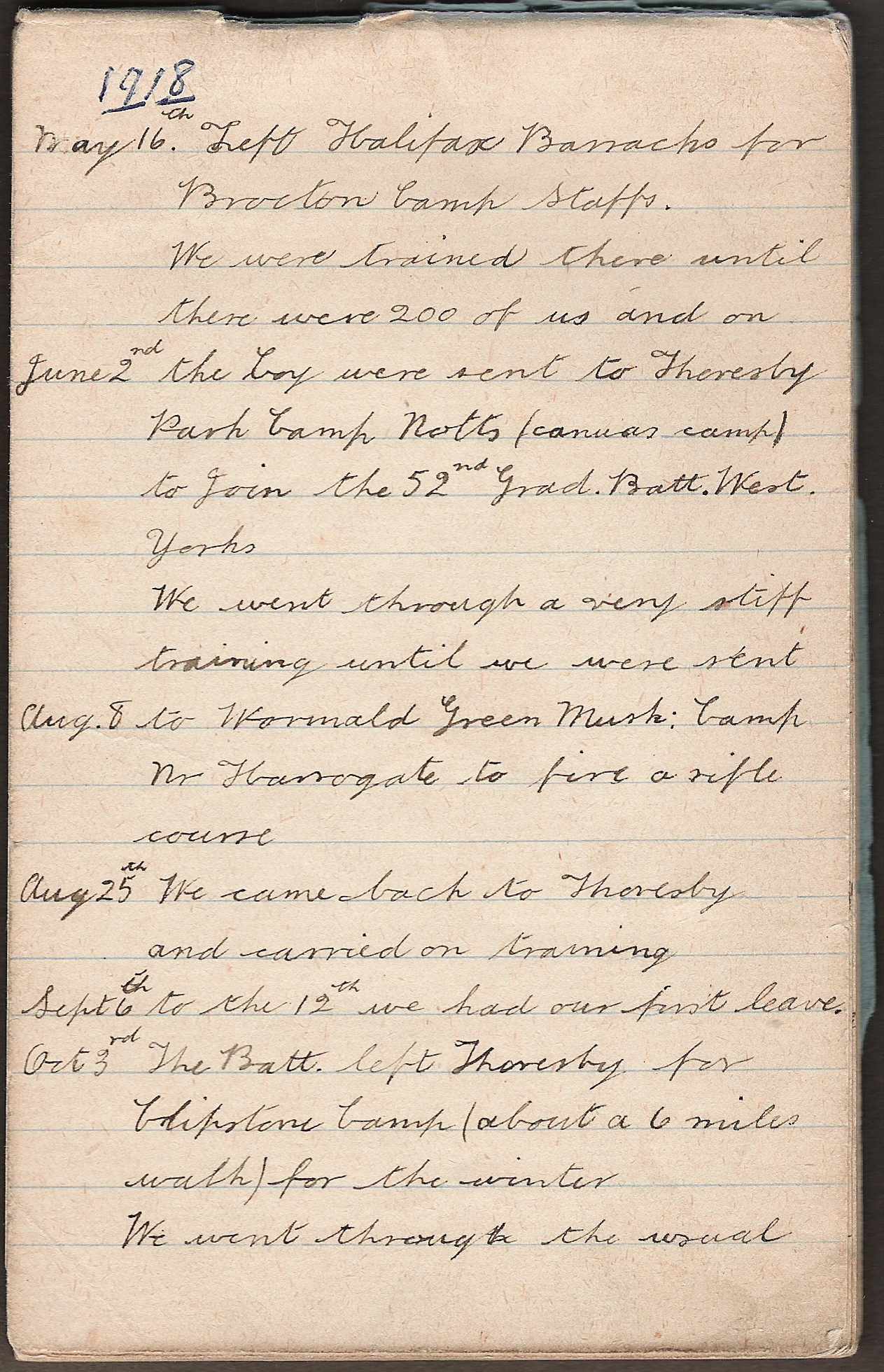
Armistice was signed today, which has saved me from having to fight in the Great War. For the past seven months I have been training with the army. On May 16 we left Halifax Barracks for Brockton Camp (canvas camp) in Staffordshire. We were trained there until there were 200 of us and on June 2 the Coy were sent to Shoresby Park Camp, Notts to join the 52nd Grad. Batt. West Yorks.
We went through a very stiff training until, on August 8 we were sent to Wormald Green Musk. Camp, near Harrogate to fire a rifle course. On August 25 we came back to Shoresby and carried on training and from September 6 to 12 we had our first leave.
On October 3 the Battalion left Thoresby for Clipstone Camp (about a six mile walk) for the winter. We have been training as usual up until today's announcement of the Armistice. I hope that means that things will ease off a little nowDetail above and in the following entries is taken from
Edwin’s contemporary real diary kept in a Reporters Notebook.
The first page is shown to the right or see the link for a full transcription.
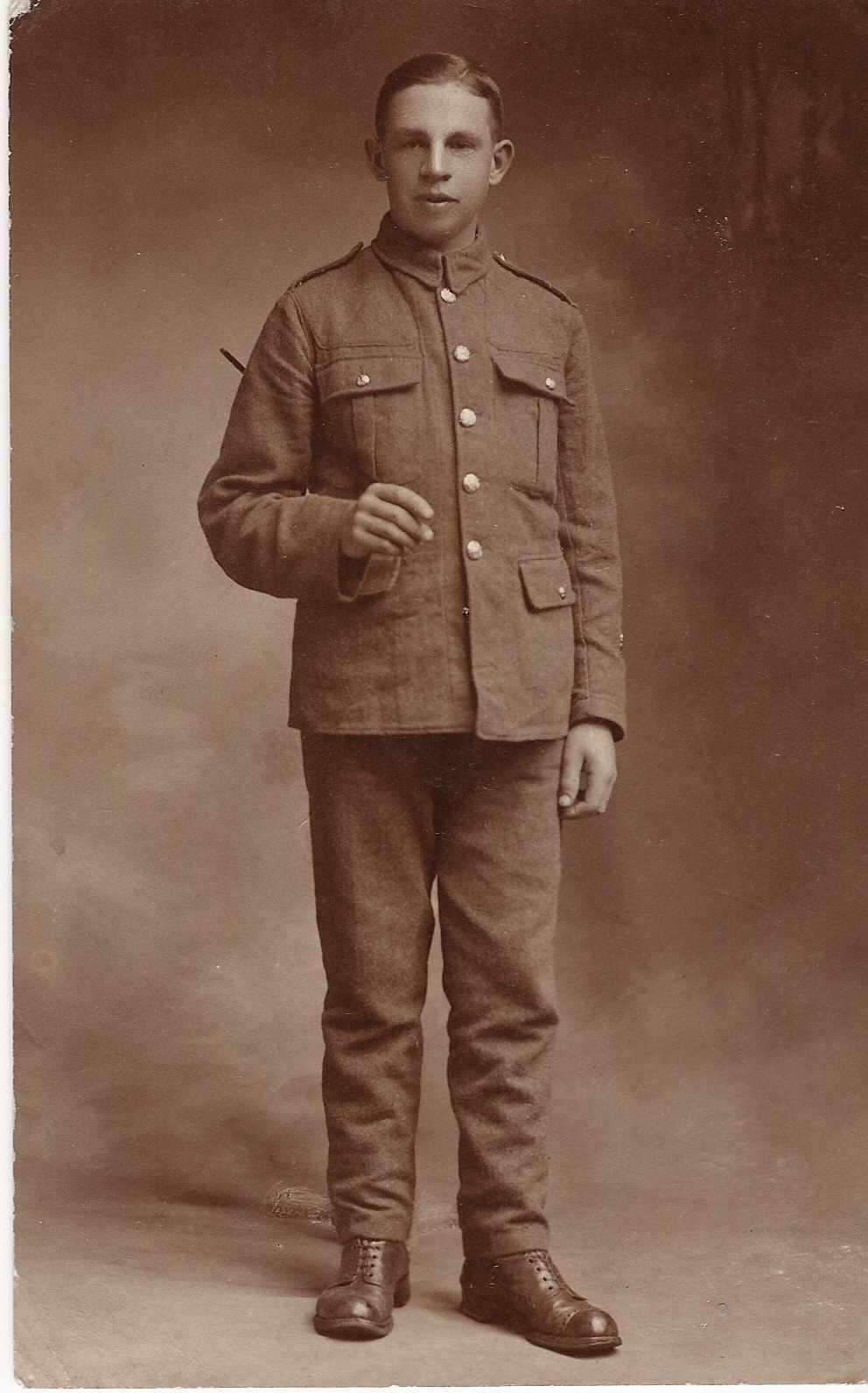
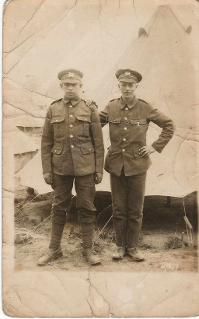
Photographs from left to right:
Edwin in military uniform - on the back this says ‘Boothman 262 Halifax Road’
Edwin on the left - other soldier unknown – this is presumably at the canvas camp at Brocton
Group in uniform - Edwin 4th from the left on the top row
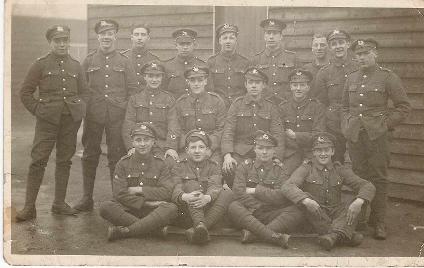
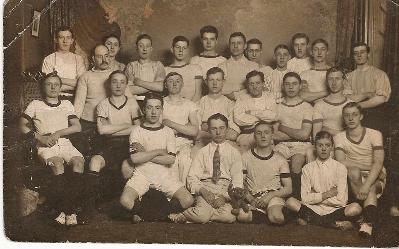
20 June 1919 - Edwin (19)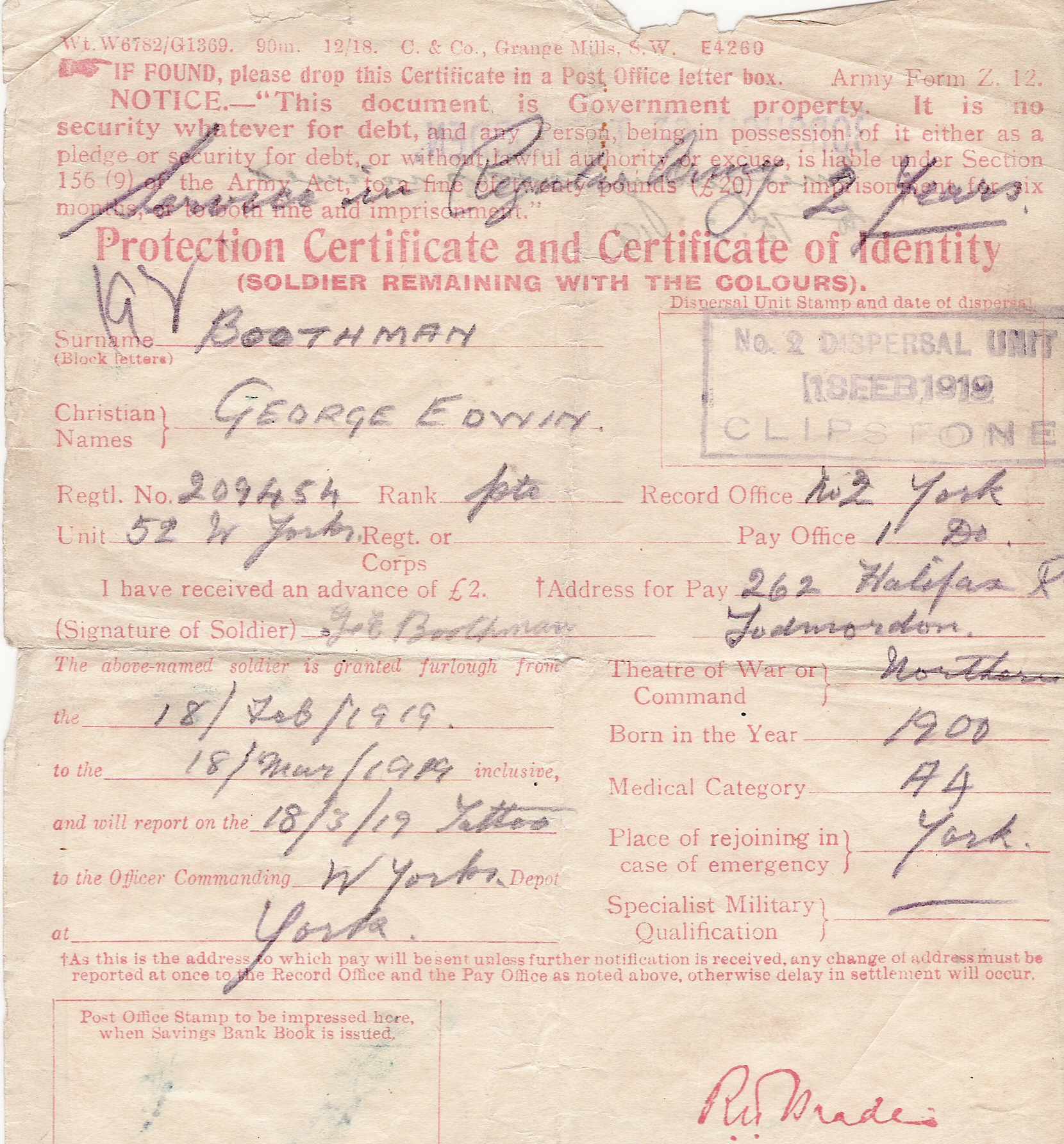
Today our Corps was broken up and I with a good many others from the West Yorks, was sent to the 19th Machine Gun Corps stationed at Dilgate Camp in Shorncliffe, Kent.
We have been sent all over the place since I re-enlisted with the West Yorks in February. After the War ended the King granted a 12 day Victory Leave to all troops in England, which we took from 2 to 13 January 1919.
On February 15 I re-enlisted in the West Yorks for 2 years (to expire on March 31 1921) and on February 18 I proceeded home for two months leave, rejoining the Regiment at York Barracks on April 19. On 25 April I was transferred to the 3rd Batt. West Yorks at Salisbury Plain and on May 19 I was transferred again to the Machine Gun Corps and we were sent to Grantham where we trained for the last month.
Image shows certificate for leave of 18 Feb 1919 to 18 March 1919 – stamped on the back BOROUGH OF TODMORDEN and handwritten ‘Emergency cards issued to 15.2.19’
2 September 1919 - Edwin (19)
WW1 was formally over but fighting continued in Russia where the W Yorks was sent to hunt down ‘Bolsheviks’.
We embarked on the S.S. Kildonan Castle at Tilbury Docks in London on August 16th. Before we left we had been given a draft leave (August 5th to 10th) and a whole arm full of inoculations (August 11th)!
We arrived at the Murmansk Coast on August 25th and disembarked and on the following day we left Murmansk, travelling in cattle trucks for four days to reach the line. We stayed the night of the 28th at Herst and the next day we stopped at Medriga-Govra, which was made the Machine Gun Corps Headquarters. This town lies on the right of Lake Onega, the largest lake in Europe at 600x400 miles.
Today we have moved to Kapasalga where we shall stay for a few days doing out-post duty and getting the guns ready.17 September 1919 - Edwin (19)
We have been relieved today after 3 days of action and have gone into billets at Nijie-Selga.
We went into the line at 10-o-clock on the night of Saturday September 13th. The advance began at four-o-clock on Sunday morning. We had not gone very far before he opened on us with a good many machine guns and rifles. We all lay down and he held us there for 2 hours. Then we had to get up and rush to a different place where we could fire at him and the bullets were flying all around us. We succeeded in driving him out of this stronghold and kept him on the move until night. But as he retired he blew up the railway bridges and we had to go round streams and sometimes go through them. Our only meal that day was breakfast, which we had at 4am.
The next day he again put up a good fight at a well-fortified village Nigie-Govra. At this place he had an ammunition train on the line and our artillery set it on fire. We had to advance through this village with the shells and bullets flying all around us.
We halted for the night in the woods and we had to do guard all night. We got our second meal at midnight.
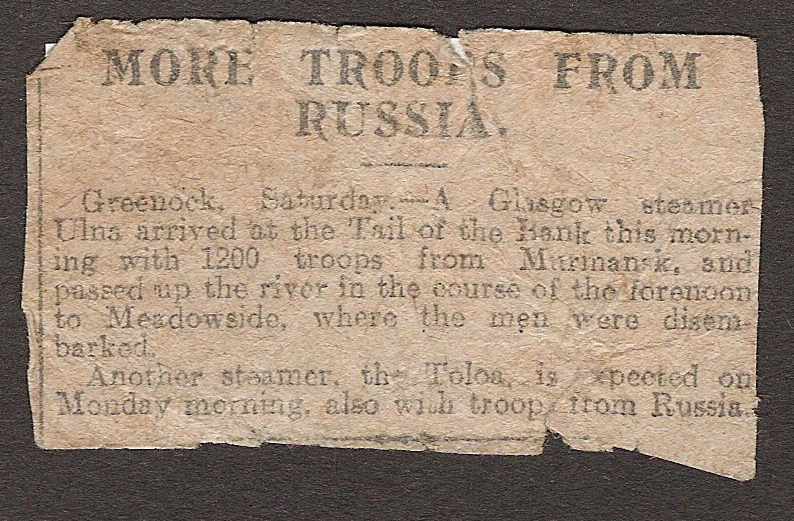
October 1919 - Edwin (19)
After we were relieved from the fighting we were billeted in Nigie-Selga until the remainder of the Corps joined us. We then proceeded to the Machine Gun Corps Headquarters at Medriga-Govra and were there for three days until leaving for Poppof, a small port, on September 27th. It took us two days to get there and we were then taken from the coast in tugs to the S.S. Schleswig, a German boat, which took us to Murmansk. We disembarked and went in billets at Kola, a village about seven miles from the coast.
Finally on October 3rd we embarked on the S.S. Ulna at Murmansk and after a very rough voyage we arrived at Glasgow. We then entrained for Shorncliffe where we were put in a rest camp, cleaned up, given new clothes and sent on two months leave.
Finally on October 3rd we embarked on the S.S. Ulna at Murmansk and after a very rough voyage we arrived at Glasgow. We then entrained for Shorncliffe where we were put in a rest camp, cleaned up, given new clothes and sent on two months leave.Press cutting tells of the arrival of the Ulna.
The Russian currency was kept as a souvenir - I have it still.
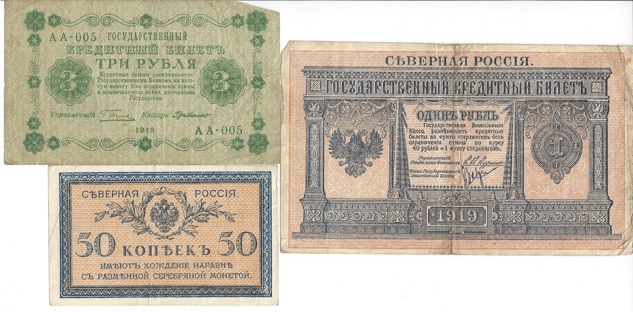
31 March 1921 - Edwin (21)
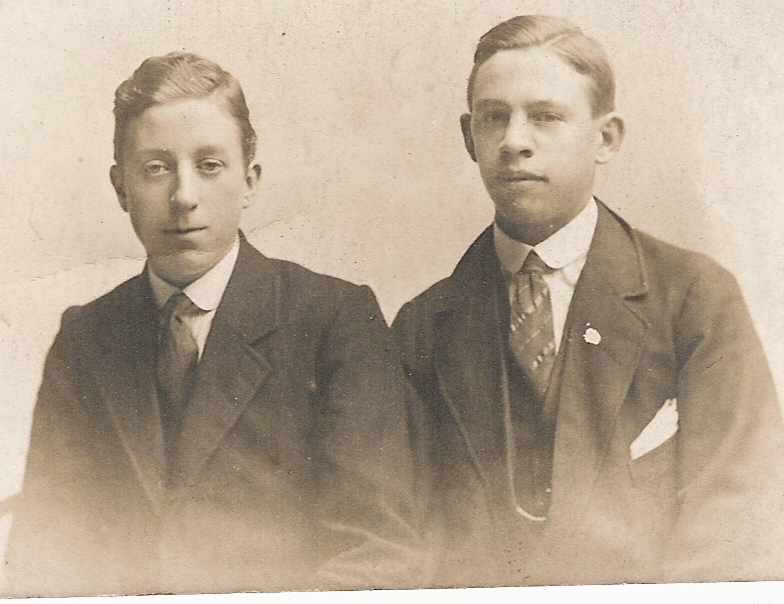
Today, five days after my 21st birthday, I was discharged from the army.
I believe it was Muriel who told me that the person with Edwin in the photograph on the right was Fred. He is also in the group of 4 (below - Edwin marked with a cross) but I never knew who the others were. I do not know the date but I thought these were probably 'demob' photos as I have a similar one for the Swinburn family. The problem with the dating is that in 1921 when Edwin was discharged, Fred would only have been 14 - he looks older in these photos.
I do not know the name of the man on the far left but the man on the right looks very similar to Fred and is probably their brother, Jack. This is supported by the fact that his right hand appears to be bandaged. Although Edwin was young enough to miss the fighting of WW1 - his brother Jack did serve and was injured. Muriel told me that he was gassed and got shrapnel through his hand, which left it damaged. In later years he wore a black glove most of the time but when he took it off you could see where the shrapnel had gone through.
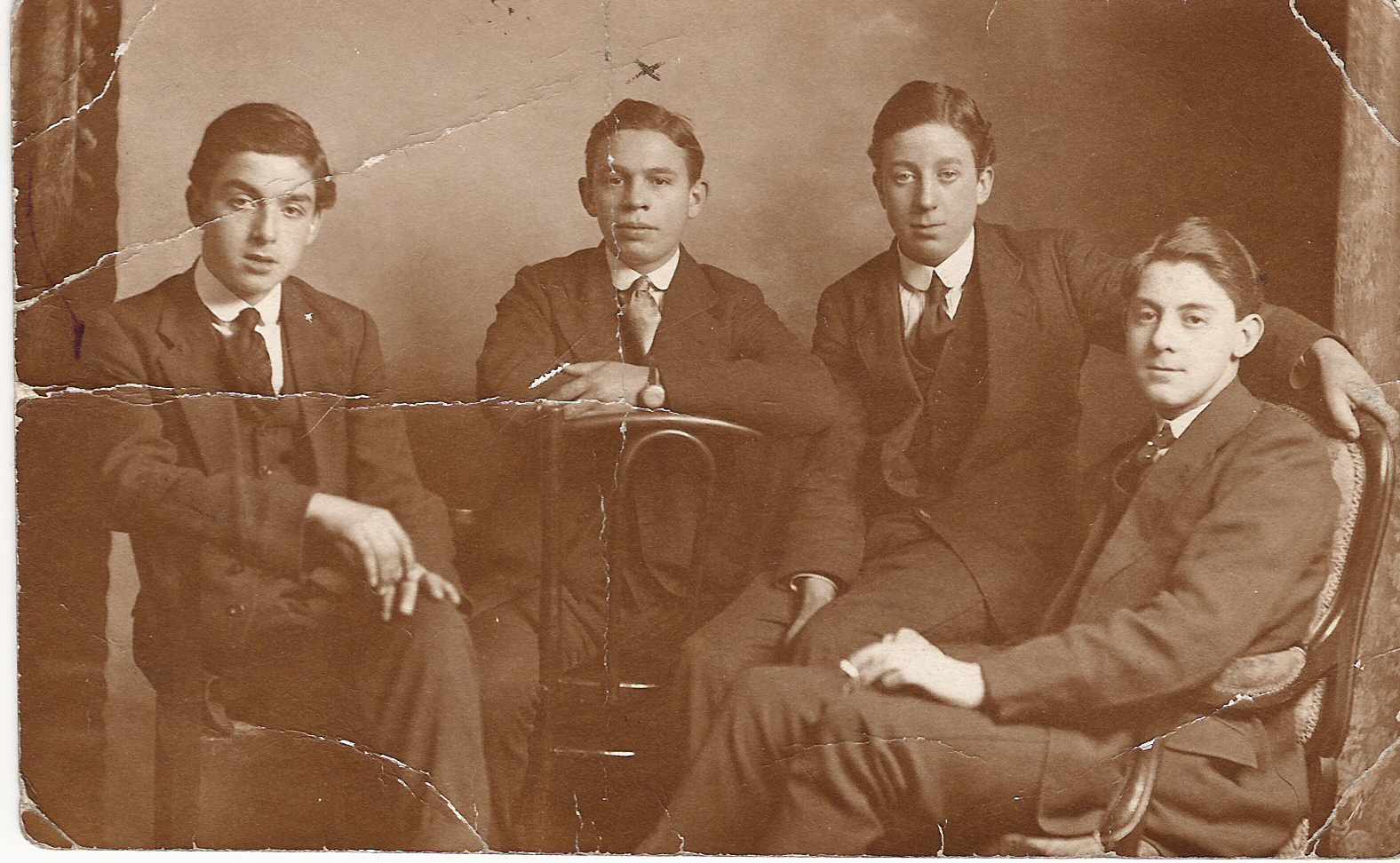
The certificates below are the Character Certificate (left) and Discharge Certificate (right) both dated 31.3.21, The first states that his character was "Very Good, Honest, sober, reliable".
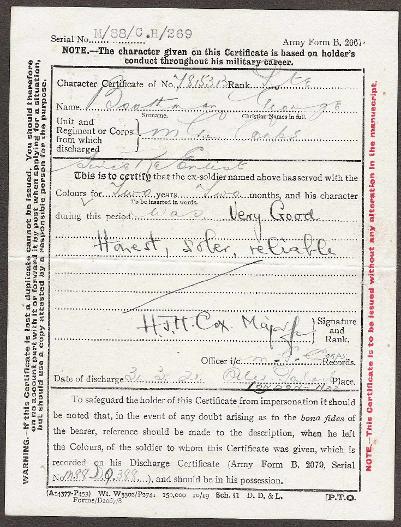
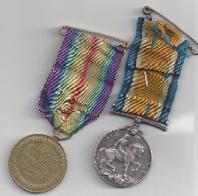
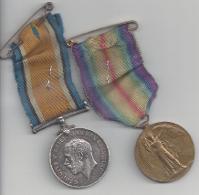
The pair of medals (shown above back and front) was awarded to all who served in WWI - both medals have name and number around the edge - 1929.9.8 Pte G E Boothman M G C
The certificate from the Machine Gun Corps (right) lists 10
locations on the banners at the top including N W Russia, which is where Edwin
served. Both it and the medals have his name and number although the number on
the Discharge and Character certificates is different (7815313).
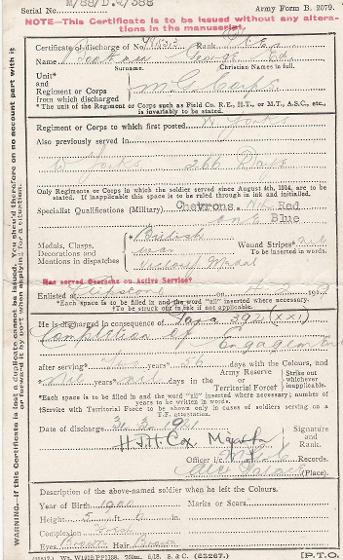
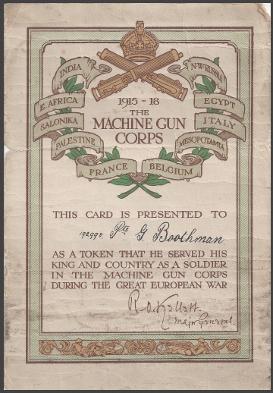
1921 - Edwin (21)
The pictures below show two outings by charabanc - (the date is approximate). The man standing in the chara with pneumatic tyres (right) is my Uncle Sandy. He started out making and selling ice cream but later had a chip shop.
My Grandfather Edwin Green Robinson was an engineer for the cotton industry from Manchester. His services were in wide demand and he went to work in Holland where he met and married a Dutch girl Johanna. The first four of their children (Edwin, Sandy, George and Sarah) were born in Holland but the family returned to England and settled in Todmorden (Richmond Street) where Hannah and Ben were born. In Todmorden, Edwin and Johanna Robinson started an ice-cream manufacturing business and all their children, except my mother Sarah, continued in the business. One of them, Edwin, emigrated to New Zealand and Uncle George lives in Wallasey. My grandparents moved to Southport where Edwin died in 1901 (I never knew him) and my Grandmother, Johanna, died in 1911. All Edwin and Johanna's children had red hair but none of my brothers and sister has inherited it. (My brother, Jack, later had a red haired daughter Edna.)
Full details about the Robinson family can be found in the section Robinson Line.
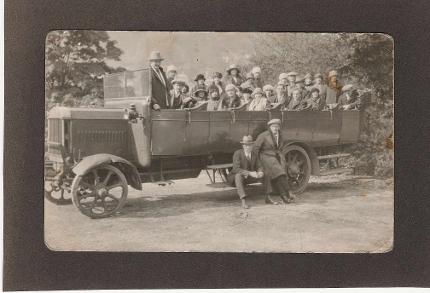
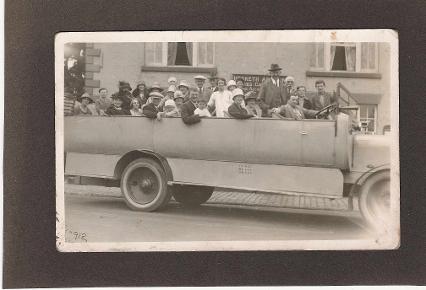
My sister Mary has had a baby girl. They have called her Alice.
30 April 1923 - Edwin (22)
Bertha and I were married today!
There are no real wedding photos but I have
always understood that this one (left) was taken on their way to Blackpool for the honeymoon. However, there
is clearly a woman standing to Bertha’s right, which perhaps makes this
unlikely. Neither Bertha nor Edwin
looks very happy. For more information about this see Bertha's Story.
This formal photograph of Edwin (right) has him in the same suit but it seems odd for a wedding photograph to not show the bride.
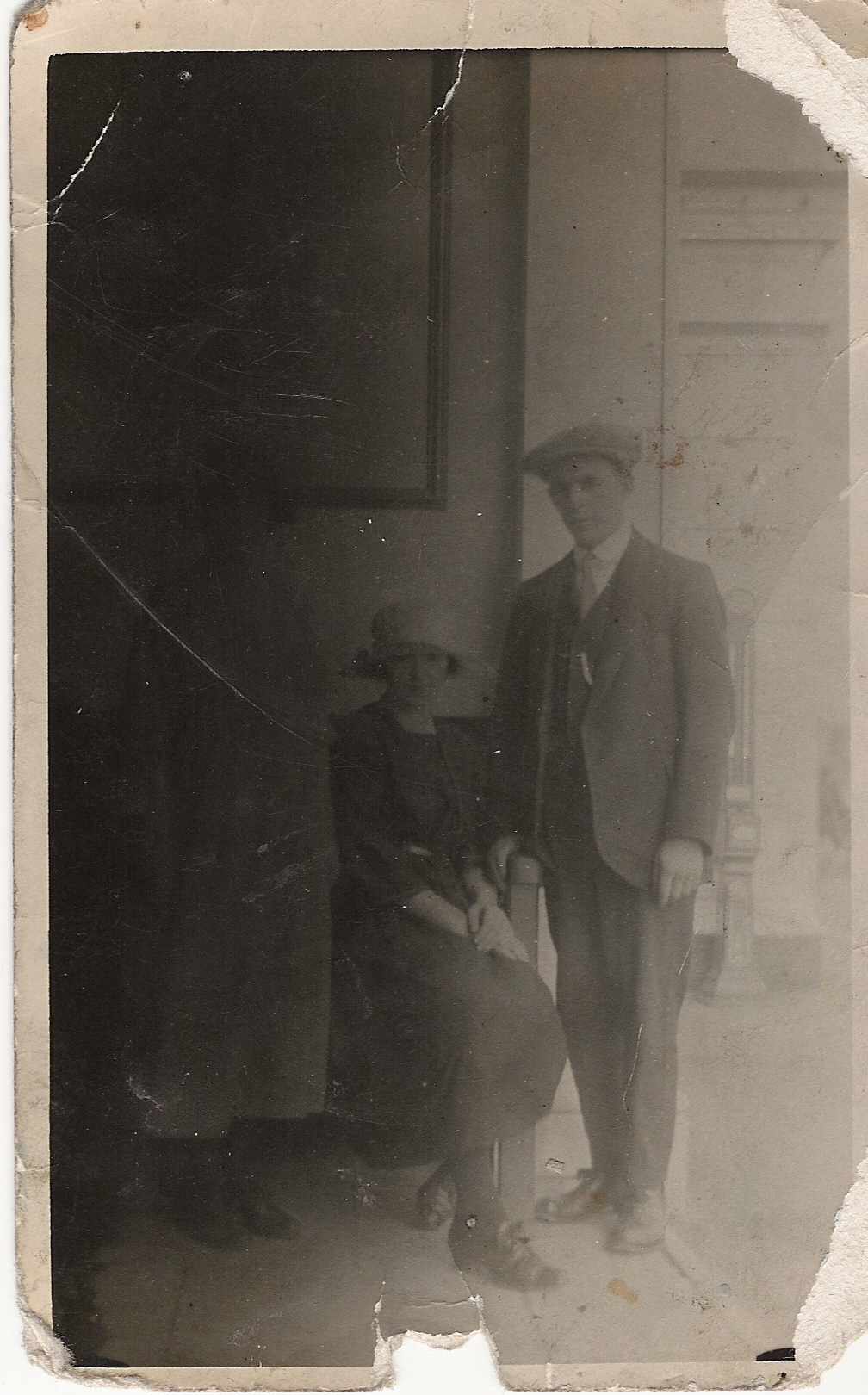
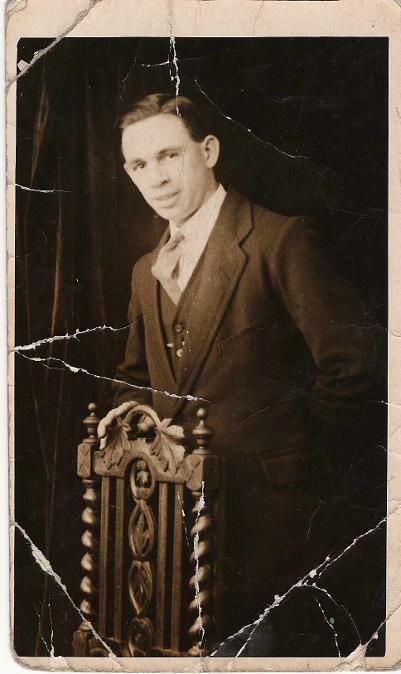
Footnote - Edwin Boothman outline Biography 26 March 1900 - 7 December 1993
George Edwin Boothman was born on 26th March 1900, the third of six children of William Boothman and his wife Sarah. William was a butcher in the Yorkshire town of Todmorden and the family lived at 6 Swan Place. Edwin attended Castle Hill School until the age of 12 when he became a 'part-timer', working half a day in the cotton mill as a weaver and attending school for the remaining half. On reaching 14, Edwin left school to work full-time in the mill but after a year he left to become a trainee manager for Duckworth's, a chain of shops in the North of England.
At the age of 18 Edwin volunteered for the army but Armistice was signed before he had completed his training. After a short period of Victory Leave, Edwin re-enlisted in the West Yorkshire Regiment for a period of 2 years. During that time he saw action, fighting the Bolshevik army in Russia and later served for a period in India. On discharge from the army Edwin resumed work in the grocery trade being appointed manager at a branch of Duckworth's in Cornholme where he continued to work until his retirement in December 1964.
In 1923 Edwin married Bertha, a local girl, and the couple raised three children Muriel, Harry and John. Sadly Bertha died of heart failure in 1965 and both Edwin's sons also predeceased him, having inherited their mother's weak heart and suffering fatal heart attacks in their early 40s. When Bertha died, Edwin left Cornholme and went to live with his daughter and her family in New Mills, Derbyshire. At the age of 68, Edwin remarried and moved to the house of his new wife, Bette Davis, a widow from Wilmslow, Cheshire. He outlived her too, caring for her during a long illness until she died on 18 April 1986.
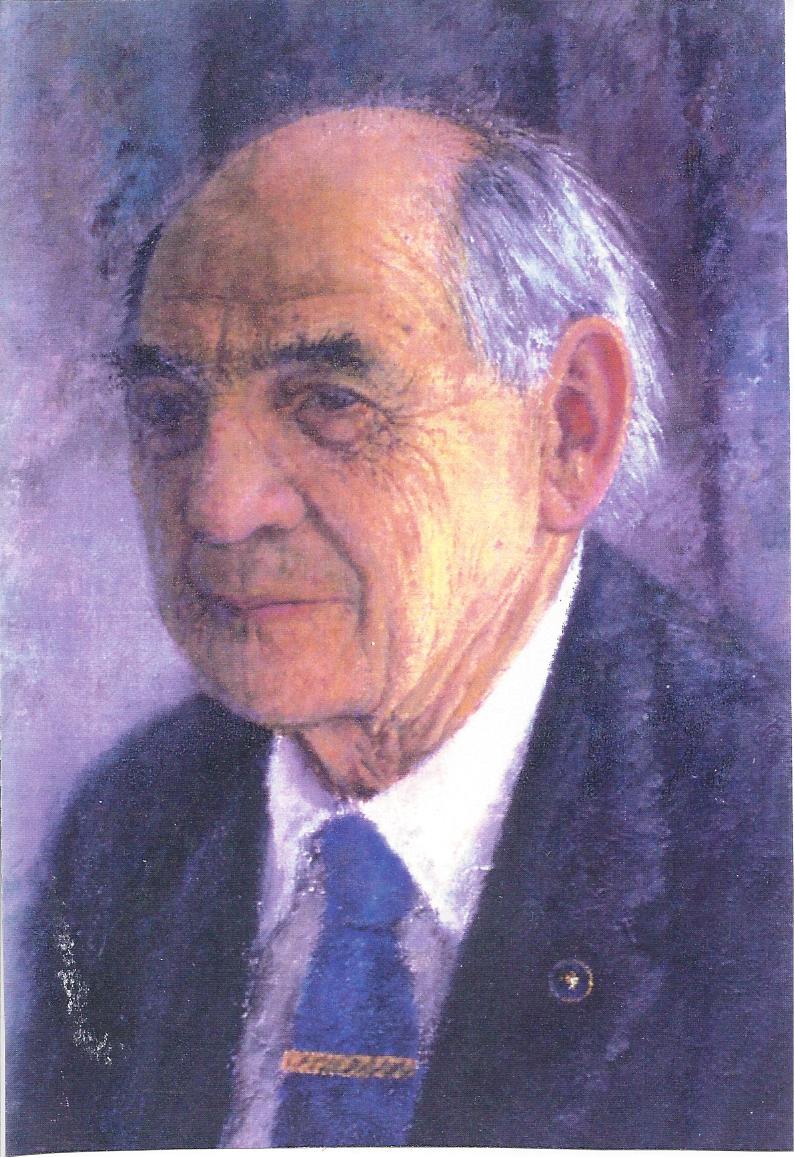 Edwin was a
committed Christian with a strong sense of public duty. He 'took the pledge' while serving in
the army and remained tea-total throughout his life. On leaving the army Edwin became an active member of the
British Legion, an organisation that aimed to help and support former
servicemen. He attended Castle Hill
Methodist Sunday School, where he became superintendent and a teacher. In the early 1940's he took up the
cause of old age pensioners, who, at that time, received a pension of merely
ten shillings per week, and because of his active campaigning on their behalf
he was asked to stand for Todmorden Town Council. He accepted and stood as an Independent but never fought an
election, as he was unopposed. He
served as a Councillor and later Alderman for a total of 21 years including a
year as Mayor of Todmorden in 1950.
Edwin was a
committed Christian with a strong sense of public duty. He 'took the pledge' while serving in
the army and remained tea-total throughout his life. On leaving the army Edwin became an active member of the
British Legion, an organisation that aimed to help and support former
servicemen. He attended Castle Hill
Methodist Sunday School, where he became superintendent and a teacher. In the early 1940's he took up the
cause of old age pensioners, who, at that time, received a pension of merely
ten shillings per week, and because of his active campaigning on their behalf
he was asked to stand for Todmorden Town Council. He accepted and stood as an Independent but never fought an
election, as he was unopposed. He
served as a Councillor and later Alderman for a total of 21 years including a
year as Mayor of Todmorden in 1950.
Edwin had a long life but one which knew considerable privations in the early years and great sadness later on. His health was generally good although he was periodically troubled with stomach ulcers and he became increasingly blind and deaf in his final years. Throughout all the trials of his life Edwin never grumbled or complained but rather had a sense of thankfulness for the pleasures and for the kindnesses of those around him. He was quiet, gentle and loving with a great sense of responsibility and a selfless commitment to serving his community. Although his own schooling ended early, Edwin valued education very highly and encouraged his children and grandchildren to pursue their studies for as long as possible.
After the death of his second wife in 1986 Edwin continued to live in Wilmslow until his death from a stroke on 7th December 1993.
He was loved and greatly respected by all his family, whom he taught to share his values.
This portrait of Edwin was painted in 1984 by the artist Easa Ali who lived in the Wilmslow area. He visited the sheltered flat where Edwin lived looking for a suitable subject - he wanted to paint an elderly man. Edwin volunteered and sat for several days each week in early May. When it was complete Easa gave Edwin £16. He wrote in his diary, “I said I did not expect anything. He said he wanted me to have it with his thanks.” The painting was exhibited in Huddersfield and later in Stockport where we saw it. I have no idea who purchased it or where it is now. It is a very accurate representation except for the fact that Edwin's sight was very poor and he was seldom ever seen in real life without spectacles.